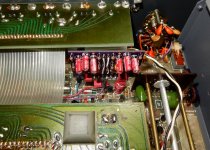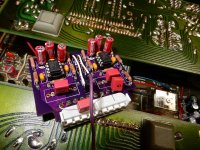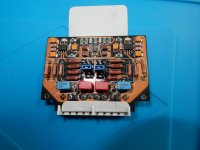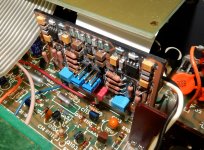While rebuilding my Apt Holman, I kept looking at the empty MC expansion header, thinking it's a shame to let it go unused, and wondered if something could be done about it. With some careful measurement of the insides & close exam of the schematics, it seemed feasible, so I decided to try building a board for it.
Having never seen an actual factory MC card (real or photos), or schematic of one, or know anyone who has one in their Apt, I didn't know how they'd built or fitted it, so had to wing it somewhat.
The goal was to build something simple & small enough to fit within the Apt confines, using quality, proven components, with performance worthy of the Apt.
It's based on the AD797 opamp, as these have been used in other MC head-amps with good results and performance, and are easier than discrete transistors for non-EEs (like me) to work with.
With the sage advice of real-life engineers, the schematic and PCB layout were drawn, and the boards fabricated and populated. Made a couple of mistakes on the physical board layout, but not the circuit, so was able to work around them.
The Apt expansion header only includes +18v, so had to bring in -18v by a separate wire tapped into the main board. Kind of a kludge, not plug-n-play, but it works.
It fits good and sounds great, so the main goal was accomplished. Concept proven, I've started working on a newer design that won't need to tap into -18v (and w/out the mistakes!).
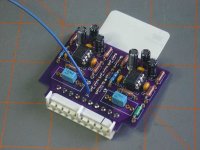
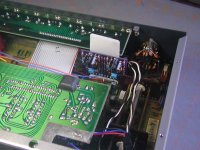
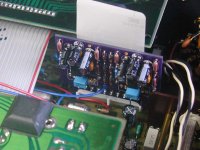
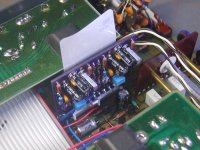
Having never seen an actual factory MC card (real or photos), or schematic of one, or know anyone who has one in their Apt, I didn't know how they'd built or fitted it, so had to wing it somewhat.
The goal was to build something simple & small enough to fit within the Apt confines, using quality, proven components, with performance worthy of the Apt.
It's based on the AD797 opamp, as these have been used in other MC head-amps with good results and performance, and are easier than discrete transistors for non-EEs (like me) to work with.
With the sage advice of real-life engineers, the schematic and PCB layout were drawn, and the boards fabricated and populated. Made a couple of mistakes on the physical board layout, but not the circuit, so was able to work around them.
The Apt expansion header only includes +18v, so had to bring in -18v by a separate wire tapped into the main board. Kind of a kludge, not plug-n-play, but it works.
It fits good and sounds great, so the main goal was accomplished. Concept proven, I've started working on a newer design that won't need to tap into -18v (and w/out the mistakes!).




Very cool! I bought my Apt brand new in 1979, I will never part with it. Recapped it two years ago, now rebuilding the power supply with new transformer
An original owner, nice! Did you get yours with the factory MC board?
I always wanted one (worked at a dealer), but couldn't afford it when new, then stumbled across one for free in 2000. One channel was in-op, turned out 1/2 of the balance op-amp had failed. $8.00 to replace it and have been happily using it since.
Upgraded it a last year and set about on the MC adapter. Now it's "complete", with a new version coming!
No, I did not get it with the MC board, back in 1979, there were very few MC cartridges available. I bought it with a Hafler DH-200 amplifier, still have that also.
I've lost a channel twice now, one the Mode op amp and the other a Balance op amp, they were so cheap I bought 10 to keep on hand.
Good luck with version two! Please post updates.
I've lost a channel twice now, one the Mode op amp and the other a Balance op amp, they were so cheap I bought 10 to keep on hand.
Good luck with version two! Please post updates.
No, I did not get it with the MC board, back in 1979, there were very few MC cartridges available.
Are you using MC carts now? Any interest in trying this upgrade?
I bought it with a Hafler DH-200 amplifier, still have that also.
Well, there's more we have in common. I've got 2 DH-200s. One I built from kit (along with a DH-101) and slightly upgraded years later, still using it today. The other was a hand-me-down, it works but has a worn out power switch & needs some other TLC in general.
Good luck with version two! Please post updates.
Will do!
I'm fairly familiar with the Apt Holman, had many (long story), 10 or 12 units, including a pair of 1979 originals. I've never seen the original MC board, but I got the following from someone that would know...it was a super simple common-emitter circuit with a couple of "big" transistors run in parallel, and an extra stage of passive DC filtering because the regulator ICs were too noisy.
No, I don't have the schematic.
@seanc - nice job!
No, I don't have the schematic.
@seanc - nice job!
I'm fairly familiar with the Apt Holman, had many (long story), 10 or 12 units, including a pair of 1979 originals. I've never seen the original MC board, but I got the following from someone that would know...it was a super simple common-emitter circuit with a couple of "big" transistors run in parallel, and an extra stage of passive DC filtering because the regulator ICs were too noisy.
No, I don't have the schematic.
@seanc - nice job!
Thank you!
I had also heard that description of the board, but even more, that the parallel transistor arrays were on a separate daughter-board. Perhaps there was a generic plug-in board with all the common components & power filters, while the cart-specific parts were on the daughter-board. Will never know for sure without seeing one.
Without a schematic tho, I'm not EE savvy enough to try designing discrete circuits, particularly with the measuring & matching that might be needed. Opamps are "cookbook" enough that even I couldn't screw it up too badly.
I have no way to measure its performance, but audibly I think it's at least equal to the Apts inherent performance.
Thank you!
I had also heard that description of the board, but even more, that the parallel transistor arrays were on a separate daughter-board. Perhaps there was a generic plug-in board with all the common components & power filters, while the cart-specific parts were on the daughter-board. Will never know for sure without seeing one.
Without a schematic tho, I'm not EE savvy enough to try designing discrete circuits, particularly with the measuring & matching that might be needed. Opamps are "cookbook" enough that even I couldn't screw it up too badly.
I have no way to measure its performance, but audibly I think it's at least equal to the Apts inherent performance.
It was one board, no cart-specifics. If I ask the right guy real nice, I might come up with a schematic, though I'm sure yours will be just fine. Remember, the parts available in 1978 were not like what we have now.
I'll just toss this in because it came up...there was evidently a change in manufacturing of the TLO72 some time when TI moved the factory some time late 1980s, early 1990s, and the later ones "weren't as good", I think in the noise spec. But useful to note that if you have to change a original dead TLO72 it might be work considering something else. I'm not swapping any of mine because it's a pain and they're all still working.
I can vouch for the design concept and execution by HalfApt! He was kind enough to provide a board for me to build, which I did using the same high-quality, close-tolerance parts, adjusting only for R and C loading of my cartridge. Because this was essentially a beta version, there were a couple of parts tacked into position, but the new board design will conserve on space and provide some additional flexibility for loading.
As built, it sounds excellent. Extremely quiet, very neutral, and it really completes the entire preamp with newer technology design and parts compared to the individual MC boards sold originally by Apt. I see no reason to try to clone the original design. This was also quick and easy to build, and cost for parts was very reasonable.
As built, it sounds excellent. Extremely quiet, very neutral, and it really completes the entire preamp with newer technology design and parts compared to the individual MC boards sold originally by Apt. I see no reason to try to clone the original design. This was also quick and easy to build, and cost for parts was very reasonable.
Attachments
Last edited:
Yah, the AD797s work fine, so I wouldn't try to replicate the original, but it would be very interesting to see, just for curiosity sake. It's surprising that with all the Apts still in the wild, nobody has found one with an MC option installed.It was one board, no cart-specifics. If I ask the right guy real nice, I might come up with a schematic, though I'm sure yours will be just fine. Remember, the parts available in 1978 were not like what we have now.
Appreciate the heads up, but all the TL072s were upgraded with newer parts during the rebuild.I'll just toss this in because it came up...there was evidently a change in manufacturing of the TLO72 some time when TI moved the factory some time late 1980s, early 1990s, and the later ones "weren't as good", I think in the noise spec. But useful to note that if you have to change a original dead TLO72 it might be work considering something else....
This is what I have in mind for the 2nd. version:
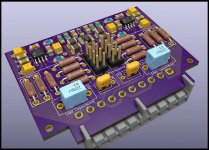
Thanks for being a willing beta-tester/guinea-pig!I can vouch for the design concept and execution by HalfApt! He was kind enough to provide a board for me to build, which I did using the same high-quality, close-tolerance parts, adjusting only for R and C loading of my cartridge. Because this was essentially a beta version, there were a couple of parts tacked into position, but the new board design will conserve on space and provide some additional flexibility for loading.
Version-2 is built, tested, installed and working great!
This one has on-board low-noise split-supply adapter, so 100% plug-n-play. No more tapping into -18v from main board.
Load resistance jumper selectable. Gain resistors & load capacitor socketed, so easy to change at will (w/out de-soldering re-soldering) to accommodate any cartridge.
Sounds fantastic, slightly lower noise than first version.
It's a tiny thing, the SMT parts were challenging:
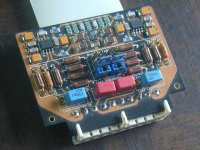
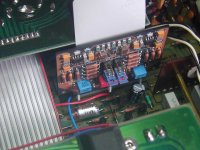
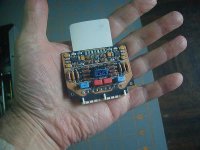
This one has on-board low-noise split-supply adapter, so 100% plug-n-play. No more tapping into -18v from main board.
Load resistance jumper selectable. Gain resistors & load capacitor socketed, so easy to change at will (w/out de-soldering re-soldering) to accommodate any cartridge.
Sounds fantastic, slightly lower noise than first version.
It's a tiny thing, the SMT parts were challenging:



Thank you! It did turn out better than I expected.Beautiful work! Work of art with the SMD parts, very impressive.
I had done very little SMD hand-soldering before, but I knew going in, with the complexity and close spacing on this board, that I couldn't do it by hand, so went to a more "pro" approach (that I wanted to learn anyway).
Used a stencil & solder paste, did the actual soldering via the "hot-plate" method on the kitchen cook stove! Was able to match the solder thermal profile to w/in 5%.
Most important, it works great, every bit as good as the first version, perhaps better, with less noise!
It's a keeper!
Hello,
I'm late on the subject, but do you plan to sell some ?
And if yes, at what price ?
I own an Apt Holman preamplifier and would like to own one.
Not selling, sorry. Only 3 boards were made and they are all spoken for.
I'd be happy to provide board files if you want to have some made, and a parts BOM, but you'd have to build it yourself.
The surface mount parts are very challenging, I would not recommended if you're not comfortable soldering tiny parts (0.5mm pin-spacing).
I'm the builder of the other 2 cards that Sean has created (one built, the other waiting for me to build up my confidence to do the next round of SMD placement and soldering), and I built one of his Version 1 boards. Version 2 is much more self-contained, very versatile, and excellent-sounding. However, the SMD construction does require careful planning and execution. I messed up my first attempt when I installed a resistor in the wrong location, and in testing fried a couple of $10 components. However, that experience has helped me develop a slightly different process that I'll use on my second board.
Sean's Version 1 was excellent, but his Version 2 design is really impressive. I have never owned the original Apt MC board, but I really prefer the advantage of more state of the art components and design and DIY nature of Sean's board. Here are a couple photos of my build.
Sean's Version 1 was excellent, but his Version 2 design is really impressive. I have never owned the original Apt MC board, but I really prefer the advantage of more state of the art components and design and DIY nature of Sean's board. Here are a couple photos of my build.
Attachments
- Home
- Source & Line
- Analogue Source
- Apt Holman plug-in MC expansion board
